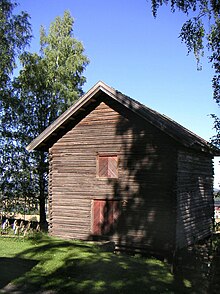46:
19:
57:
In the first years, on every Sunday after the sermon, the local regiment would drill outside the church. After 1774 this location was changed in favour of special exercise or parade grounds, with annual musters of 12 days. At these places the "tent houses" were built.
117:, which consisted of a series of declared and undeclared wars based on religious and economic objectives that raged throughout central and northern Europe in 1618–1648. Denmark-Norway actively participated in the Thirty Year War (see
105:
Northwestern Europe witnessed warfare on a scale not previously experienced during the period between 1558 and 1721. Military change was rapid and extensive in Norway, modifying the army structure and increasing the
121:) between 1625 and 1630. The French, English and Dutch opposed the Habsburg Empire. When the Empire attacked Danish possessions on the Baltic and in northern Germany,
61:
Each larger farm or a number of smaller farms was obliged to supply one fully equipped soldier. This farm or group of farms was called a
171:
150:
42:
from the establishment of the regular army in 1628, and became common at the special exercise grounds.
72:
126:
122:
114:
107:
94:
50:
8:
110:
of the borders and strong points. The burdens placed on the populace grew dramatically.
146:
90:
76:
23:
45:
142:
18:
165:
118:
86:
22:
The "tent house" for the Ytre
Valdreske regiment 1813–50. Now at
65:. One person was then appointed to do the service for the legd.
39:
71:
had an exercise or parade ground located close to Bagn Kirke,
75:, down by the river. The regimental arsenal is relocated at
113:
The
Norwegian regimental army was established during the
125:'s troops joined, but were defeated by the army of the
38:) or a regimental arsenal building was in use in
163:
158:by Trygve Mathisen, Gyldendal Norsk Forlag, 1952
93:. The regimental arsenal is now relocated to
49:The tent house for Granske regiment. Now at
44:
17:
164:
100:
13:
145:; Longman, Harlow, England; 2000
14:
183:
1:
132:
156:Frå Bondeoppbud til Legdshær
139:The Northern Wars, 1558–1721
7:
85:had its exercise ground at
10:
188:
172:Military history of Norway
123:Christian IV of Denmark
73:Sør-Aurdal municipality
69:Ytre Valdreske Kompagni
54:
27:
48:
21:
95:Hadeland Folkemuseum
51:Hadeland Folkemuseum
101:Historical context
55:
28:
115:Thirty Years' War
91:Gran municipality
77:Bagn Bygdesamling
24:Bagn Bygdesamling
179:
83:Granske Kompagni
187:
186:
182:
181:
180:
178:
177:
176:
162:
161:
143:Robert I. Frost
135:
127:Catholic League
103:
12:
11:
5:
185:
175:
174:
160:
159:
153:
134:
131:
102:
99:
9:
6:
4:
3:
2:
184:
173:
170:
169:
167:
157:
154:
152:
151:0-582-06429-5
148:
144:
140:
137:
136:
130:
128:
124:
120:
116:
111:
109:
108:fortification
98:
96:
92:
88:
84:
80:
78:
74:
70:
66:
64:
59:
52:
47:
43:
41:
37:
33:
25:
20:
16:
155:
138:
119:Hannibal War
112:
104:
82:
81:
68:
67:
62:
60:
56:
35:
31:
29:
15:
87:Granavollen
133:References
32:tent house
166:Category
36:Telthus
149:
40:Norway
147:ISBN
63:legd
141:by
168::
129:.
97:.
89:,
79:.
30:A
53:.
34:(
26:.
Text is available under the Creative Commons Attribution-ShareAlike License. Additional terms may apply.

